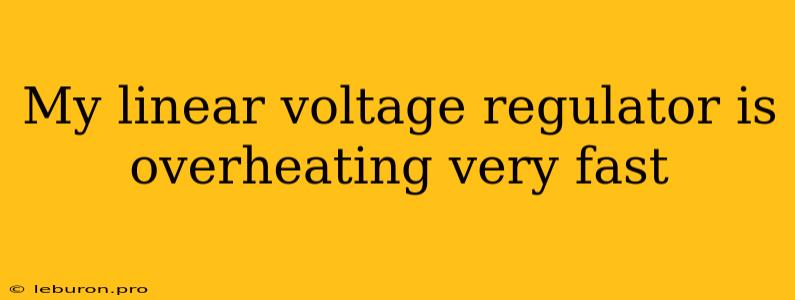Linear voltage regulators are essential components in many electronic circuits, providing a stable and regulated output voltage. However, one common issue that can arise is overheating, which can lead to component failure and system instability. If your linear voltage regulator is overheating very fast, it's crucial to understand the underlying causes and implement appropriate solutions. This article will delve into the reasons behind this issue, explore potential troubleshooting steps, and provide guidance on preventing overheating in the future.
Common Causes of Linear Voltage Regulator Overheating
The rapid overheating of a linear voltage regulator can stem from several factors. Identifying the root cause is essential for implementing effective solutions. Here are some of the most prevalent culprits:
1. Excessive Output Current:
Linear voltage regulators operate by dissipating excess voltage as heat. When the output current demand exceeds the regulator's rated capacity, the power dissipation increases dramatically, leading to rapid overheating.
For instance, if a regulator rated for 1A output is tasked with delivering 2A, the heat generated will be significantly higher, potentially causing the device to overheat and fail.
2. Inadequate Heat Sink:
Heat sinks are essential for dissipating heat generated by the linear voltage regulator. A poorly designed or insufficient heat sink will allow the regulator to reach dangerously high temperatures.
Factors like:
- Size and material of the heat sink: A larger heat sink with higher thermal conductivity (e.g., aluminum) will dissipate heat more effectively.
- Thermal interface material: The thermal paste or pad between the regulator and heat sink plays a crucial role in transferring heat efficiently.
3. Poor Airflow:
Adequate airflow is essential for cooling the heat sink and preventing overheating. If the surrounding environment lacks sufficient airflow, the heat sink may not be able to effectively dissipate heat.
Factors like:
- Enclosure design: A tightly sealed enclosure can trap heat and exacerbate overheating.
- Fan placement: Proper fan placement can create a strong airflow to cool the regulator.
4. Input Voltage Exceeding Maximum Rating:
Every linear voltage regulator has a maximum input voltage rating. If the input voltage surpasses this limit, the device will struggle to regulate the output, resulting in excessive power dissipation and overheating.
For example:
- If a regulator is rated for a maximum input voltage of 12V, applying 15V input can lead to significant overheating and potential damage.
5. Output Short Circuit:
A short circuit at the output of the linear voltage regulator can cause a significant surge in current, leading to excessive power dissipation and rapid overheating.
Factors like:
- Faulty components: Damaged or defective components in the output circuit can create a short circuit.
- Accidental connections: Improper wiring or unintentional connections can lead to a short circuit.
Troubleshooting and Solutions for Linear Voltage Regulator Overheating
Once the potential causes of overheating have been identified, the next step is to troubleshoot the problem and implement appropriate solutions.
1. Verify Output Current Demand:
Measure the actual output current flowing through the regulator using a multimeter. If the current exceeds the device's rated capacity, you'll need to consider a regulator with a higher current rating or reduce the current demand in the circuit.
2. Assess the Heat Sink:
- Size: Ensure the heat sink is sufficiently large to dissipate the heat generated by the regulator.
- Material: Consider a heat sink made of aluminum or other materials with high thermal conductivity.
- Thermal interface material: Apply fresh thermal paste or replace the thermal pad to ensure proper heat transfer.
- Airflow: Ensure sufficient airflow around the heat sink by providing adequate ventilation or using a fan.
3. Check Input Voltage:
Measure the input voltage to the regulator using a multimeter. If it exceeds the device's maximum rating, adjust the input voltage or select a regulator with a higher input voltage rating.
4. Inspect for Short Circuits:
Carefully examine the output circuit for any signs of a short circuit. Use a multimeter to test for continuity between different points in the circuit. If a short circuit is detected, isolate and repair the faulty component.
5. Temperature Monitoring:
Use a non-contact temperature sensor or a thermal imaging camera to measure the regulator's temperature. This will help you monitor its operating temperature and identify potential overheating issues.
6. Consider Alternative Regulation Techniques:
If the overheating problem persists despite implementing the above solutions, consider exploring alternative regulation techniques, such as using switching voltage regulators.
Preventing Linear Voltage Regulator Overheating
The most effective way to prevent linear voltage regulator overheating is to implement preventive measures during the design and implementation stages.
1. Choose the Right Regulator:
Select a regulator with a current rating that comfortably exceeds the expected output current demand. Consider the maximum input voltage and choose a device with a suitable input voltage rating.
2. Provide Adequate Heat Dissipation:
Use a sufficiently large heat sink with high thermal conductivity. Ensure good thermal contact between the regulator and the heat sink using thermal paste or pads.
3. Ensure Proper Airflow:
Design the enclosure or the surrounding environment to provide adequate airflow around the regulator and heat sink. Consider using a fan to enhance airflow and prevent overheating.
4. Implement Protective Measures:
Incorporate overcurrent protection circuitry to prevent excessive current flow and protect the regulator. Use fuses or circuit breakers to prevent short circuits and safeguard the regulator.
Conclusion
Overheating is a common issue with linear voltage regulators, but by understanding the underlying causes and implementing appropriate solutions, you can effectively prevent this problem and ensure the reliable operation of your electronic circuits. By following the troubleshooting steps and preventative measures outlined in this article, you can minimize the risk of overheating and maximize the lifespan of your linear voltage regulators.
